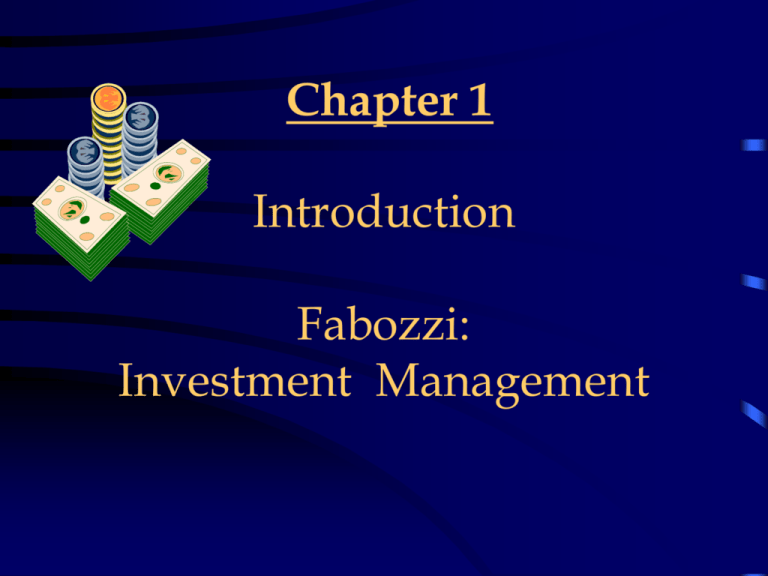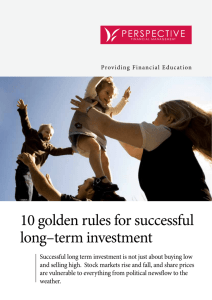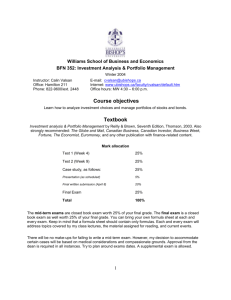Selling an Idea or a Product
advertisement

Chapter 1 Introduction Fabozzi: Investment Management Learning Objectives From this chapter... You will learn the steps involved in the investment process. You will understand the difference between retail and institutional investors. You will study the factors considered in setting investment policy. You will be able to explain what is meant by the allocation decision. Learning Objectives You will recognize various general portfolio strategies. You will be able to define an efficient portfolio. You will discover the process of evaluating portfolio performance. You will investigate the structure of the money management business. You will review the ethical issues in investment management. Investment Management Terms Portfolio Management/Money Management An investment manager “runs”money and uses • Their understanding of investment vehicles • valuation • strategies of selection to accomplish investment objectives Types of Investors Retail-Individuals like yourself Institutional- large firms in a variety of businesses with large inflows of cash Banks Pension Funds Endowment Funds Mutual Funds As most individual investors employ mutual funds rather than invest in stocks, there has been an institutionalization of the financial markets.There are fewer retail investors and the markets are moved by purchases of large blocks of shares, rather than 50 or 100 share blocks. Investment Management Process 1. Setting investment objectives 2. Establishing investment policy 3. Selecting a portfolio strategy 4. Selecting the assets 5. Measuring and evaluating performance Setting Investment Objectives Objectives will vary depending on the type of institution Pension Fund: Generating funds to pay to beneficiaries in the future and current recipients Life Insurance: Generate profits while meeting obligations of payments to clients Banks: Realize returns greater than the cost of funds(interest on accounts) Mutual Funds : Generate profits while providing strong returns for investors. Establishing Investment Policy How do we satisfy the objectives? Begin by determining how to allocate assets among investment vehicles or assets. A portfolio consists of a group of assets. Assets can include: Stocks, bonds, real estate, foreign securities, commodities, gold Constraints on how funds can be invested Regulations Amount of ownership in one asset, tax considerations. Client Amount of acceptable risk, diversification needs Selecting a Portfolio Strategy Active- applies information and forecasting techniques Financial ratios, historical yield curves, predicting dividend growth Passive- diversifies to match a market index Standard and Poor’s 500 Structured strategy is used for bond holdings where funds received from investments match the value of the liabilities to be disbursed. Choosing a Strategy Use Marketplace Price Efficiency Defined as how difficult it would be to earn a greater return than passive management would, after adjusting for risk and transaction costs associated with the chosen strategy. Client’s risk tolerance: Are they able to sleep at night while holding a risky asset or are they more conservative? (Discuss risk tolerance in daredevil sports or size of a car loan in a budget.) Nature of the client’s liabilities: Does the client need to access cash quickly or are they able to effort their lifestyle without drawing on their investments in an uncontrolled way? Selecting the Assets Active Strategy- identify mispriced securities in constructing an efficient portfolio (sometimes called value investing, can discuss the difference between a value shop and a growth shop) An efficient portfolio is one that provides the greatest expected return for a given level of risk, or the lowest risk for a given expected return. Measuring And Evaluating Performance Compare portfolio result to a benchmark A benchmark is the performance of a predetermined set of securities such as an index. Many money managers use a customized index to match the objectives of the investment. Structure of the Money Management Process In-house money managers: This is the process of making money for your own organization. Money made in the markets can be used to fund projects, bonuses, pay down debt or fund an expansion or acquisition. These money managers are motivated by their loyalty to their firm and desire to see it grow and prosper. It is possible to have both in house and outside money managers. Structure of the Money Management Process Outside money managers are hired to make money for various types of organizations. If they are successful, they will attract more clients, increase their money under management and generate more fees for their money management firm. Organizations include: Financial institutions: banks, insurance companies, investment companies. Non-financial institutions: pension funds and endowment funds. (Baby boomer generation is putting billions of dollars into pension funds and mutual funds to save for retirement. Discuss lack of confidence in Social Security and subsequent need to increase personal savings.) Structure of the Money Management Process Who are these outside money management firms? Bank related: trust departments manage funds for individuals (PNC Asset Management Group) Insurance related: subsidiaries that manage annuity type investments (Prudential Insurance) Brokerage firms: asset management subsidiaries (Merill Lynch Asset Management) Independent money management firms: mutual funds (Fidelity or Putnam) Ethics in Investment Management Money managers and broker/dealers provide services to clients. However, money managers are also the clients of broker/dealers. This leads to conflict interest. Lines of defense for client Trust ethics of service provider Industry wide policies for ethical and professional behavior. Ethics in Investment Management Violators of regulations set by the Security and Exchange Commission(SEC) or the national Association of Securities Dealers(NASD) can: • Be stripped of the right to transact business on any exchange. • Be required to compensate the client for monetary damages • Be required to pay punitive damages A Chartered Financial Analyst (CFA) can lose their right to use that designation. (Discuss The self-study, 3 grueling exams required to become a CFA and the research jobs that can follow.) (Discus the genesis of the SEC (1993) from bank and exchange excesses and fraudulent behavior in the 1920s.) Organization of the Book Section I Chapters 1 and 2:background information and an overview of market and major asset classes, including historical performance of stocks and bonds Section II Chapters 3-5 :discuss modern portfolio theory and capital market theory leading to how to determine the equilibrium price of an asset Section III Chapters 6-10 : students will learn about the considerations in managing the institutions investment portfolio including client liabilities, tax problems, and regulatory constraints Organization of the Book Section IV Chapters 11-21 : discuss common stock (equity)portfolio management including the important idea of pricing efficiency; technical, fundamental and forecasting analysis techniques; industry environment; indexing; factor models; options and futures; and equity trading Section V Chapters 22-30 : discuss fixed income portfolio management including characteristics and analytical tools, yields, active bond strategies and indexing, and futures and contracts Section VI Chapters 31-33 : show the student the mathematical models used to make asset allocation decisions, and how to measure and evaluate the performance of a money manager Organization of the Book Appendix A : reviews the fundamental concepts of probability and statistics Appendix B : reviews of the income statement and balance sheet






